
The Tortricidae are a family of moths, commonly known as tortrix moths or leafroller moths, in the order Lepidoptera. This large family has over 11,000 species described, and is the sole member of the superfamily Tortricoidea, although the genus Heliocosma is sometimes placed within this superfamily. Many of these are economically important pests. Olethreutidae is a junior synonym. The typical resting posture is with the wings folded back, producing a rather rounded profile.

Ptycholoma lecheana, the Leche's twist moth, is a moth of the family Tortricidae. It is found in Europe, China, Korea, Japan, Russia and Asia Minor.

Eupoecilia ambiguella, the vine moth, is a moth of the family Tortricidae. It is found in Europe, China, India, Japan, Korea, Mongolia and the Russian Far East.
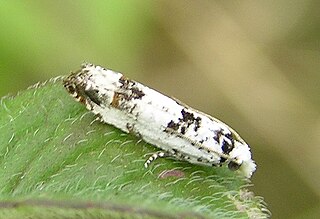
Eucosma campoliliana is a moth of the family Tortricidae. It is found in Europe, China, Japan and Russia.

The Zeiraphera griseana, the larch tortrix, is a moth of the family Tortricidae.

Adoxophyes is a genus of moths of the tribe Archipini.
Leguminivora is a genus of moths belonging to the subfamily Olethreutinae of the family Tortricidae.
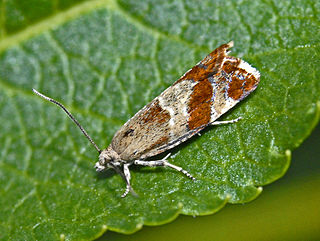
Epinotia cruciana, the willow tortrix, is a moth of the family Tortricidae.

Gravitarmata margarotana, the pine cone tortrix or pine twig moth, is a moth of the family Tortricidae. In Europe, it is found from England to Austria and Poland, east to the Baltic region to Russia, China, Korea and Japan.
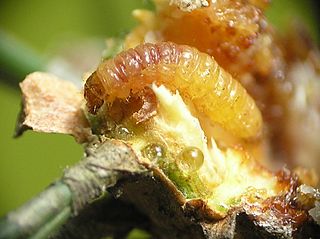
Retinia resinella, the pine resin-gall moth, is a moth of the family Tortricidae.

Epinotia tenerana, the nut bud moth or alder tortricid, is a moth of the family Tortricidae.
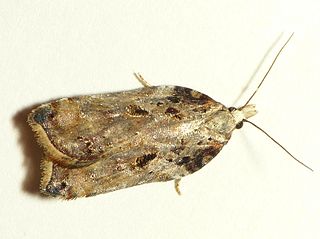
Acleris cristana, the rufous-margined button moth, is a moth of the family Tortricidae and is found from Europe through the Caucasus and Ussuri to Japan.

Grapholita molesta, the oriental fruit moth or peach moth, is a moth of the family Tortricidae. It is native to China, but was introduced to Japan and North America and is now also found throughout of Europe, Asia and South America and in Hawaii, Morocco, Mauritius, South Africa, Australia and New Zealand
Mictocommosis nigromaculata is a species of moth of the family Tortricidae. It is found in Japan, as well as Vietnam.
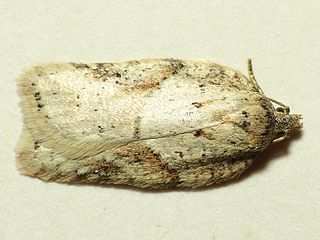
Acleris logiana, the black-headed birch leaffolder moth or grey birch button, is a moth of the family Tortricidae. It was described by Carl Alexander Clerck in 1759. It is found in most of Europe, except Ireland, Portugal, most of the Balkan Peninsula and Ukraine. It is also found in North America, the Russian Far East, Korea and Japan.

Phalonidia curvistrigana, the golden-rod conch, is a species of moth of the family Tortricidae. It is found in China, Japan, Korea, Russia and most of Europe. The habitat consists of woodland and scrubland.

Phtheochroa inopiana, the plain conch, is a species of moth of the family Tortricidae. It is found in China, Iran, Japan, Mongolia, Russia and most of Europe. It has also been recorded from North America. The habitat consists of damp areas and woodland edges.
Archips breviplicanus, the Asiatic leafroller, is a species of moth of the family Tortricidae. It is found in Japan, South Korea, China and Russia.
Archips fuscocupreanus, the exotic leafroller moth or apple tortrix, is a species of moth of the family Tortricidae. It is found in China, South Korea, Japan and Russia. It is an introduced species in the north-eastern United States, where it has been recorded from Connecticut, Massachusetts, New Jersey, New York and Rhode Island. It has also been recorded from Washington.

Acleris lacordairana is a species of moth of the family Tortricidae. It is found in Germany, Austria, Switzerland, Italy, Hungary, Poland, Estonia, Latvia and Russia. In the east, the range extends to Japan.















